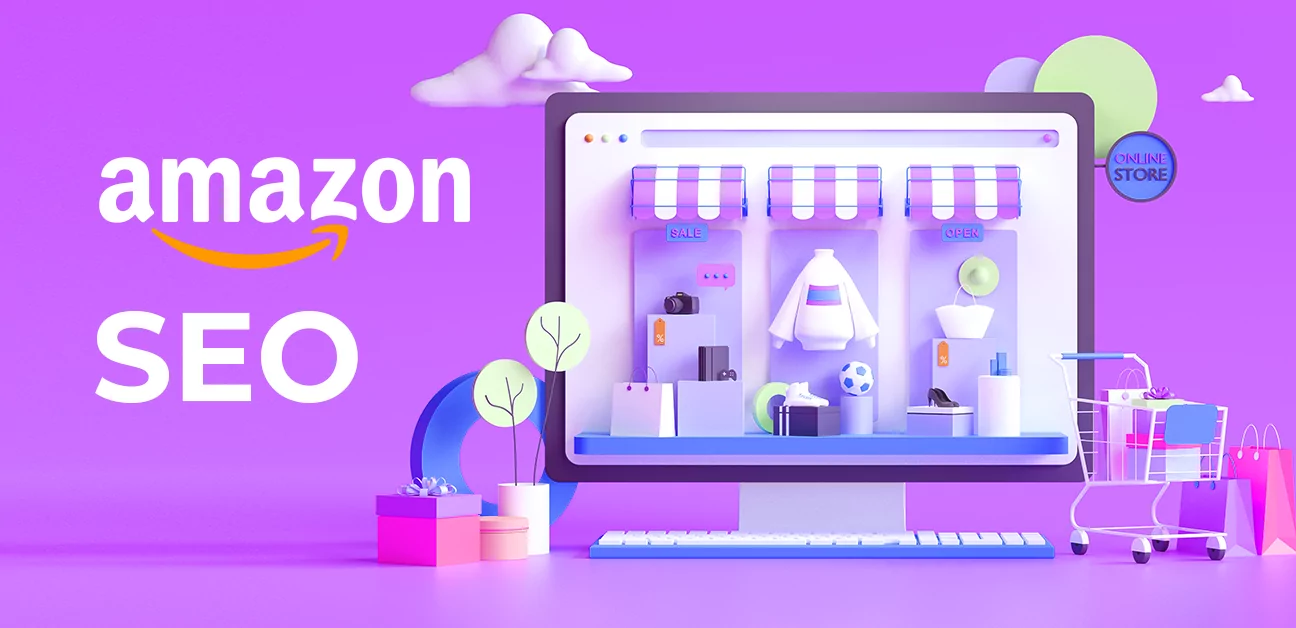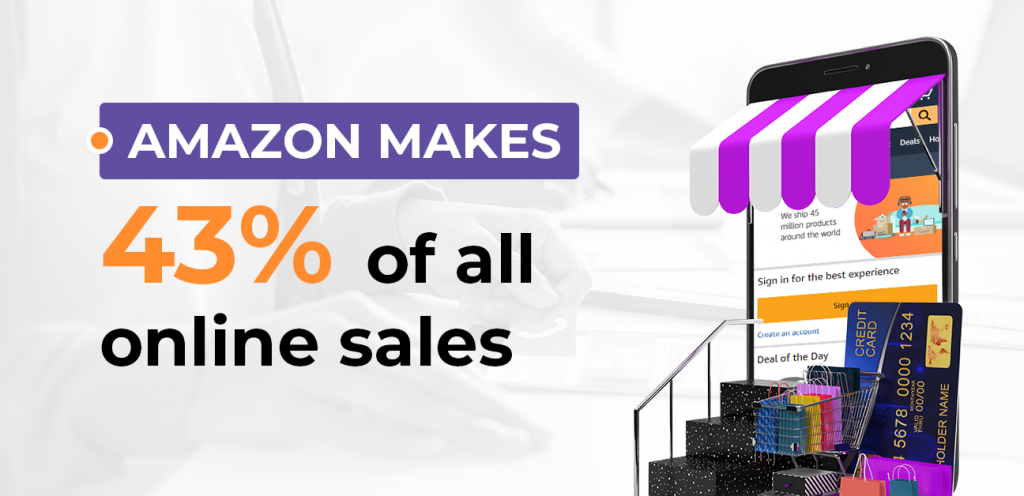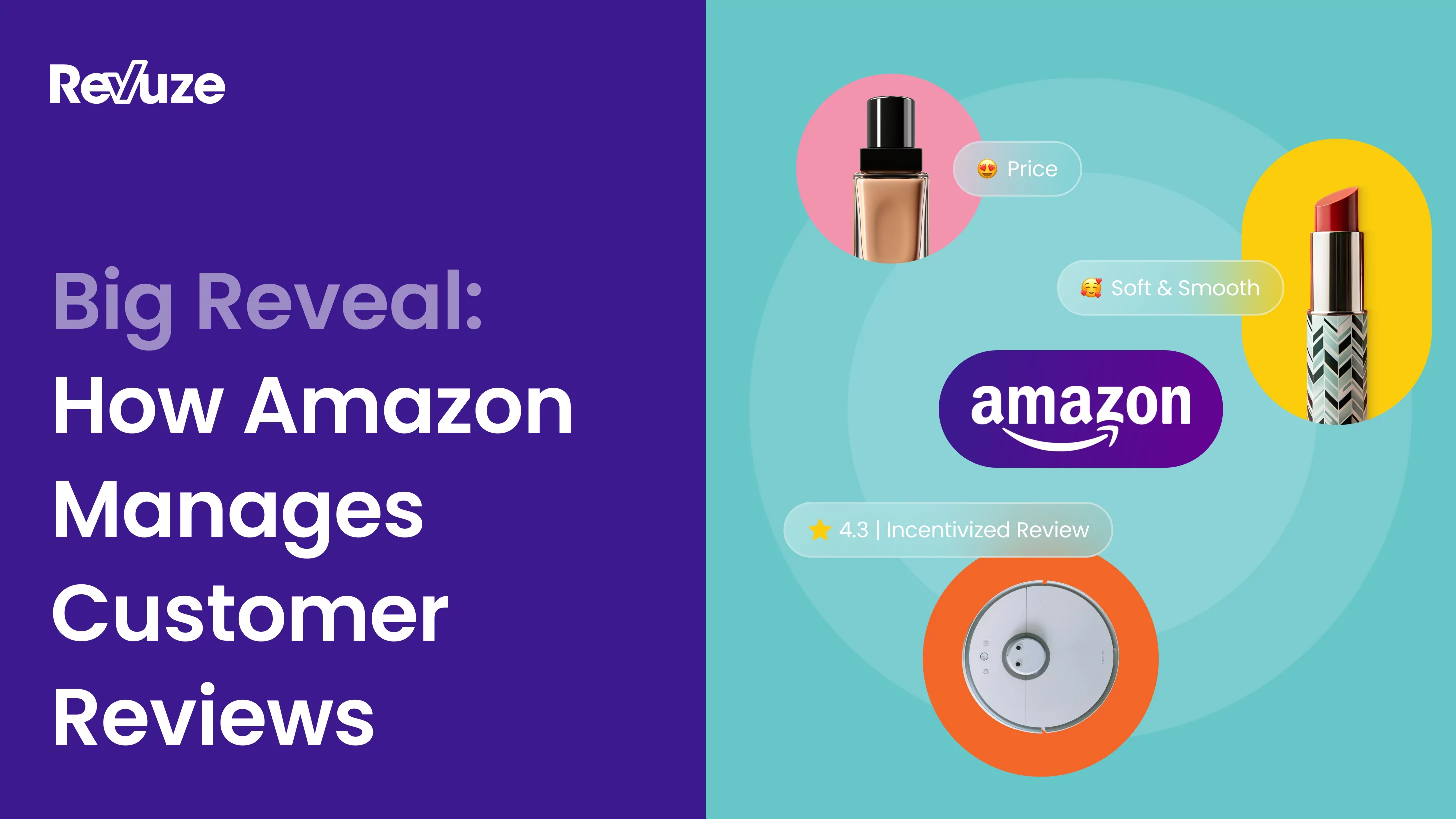
Billions of people visit Amazon every month looking for products.
Amazon makes up 43% of all online sales.
If you think ahead of Google, Amazon is one of the best places to sell your product online.
The best part of Amazon is, people already know what they want, so the searcher’s intent is purely commercial.
You have higher chances of generating sales if you can rank your products in the Amazon search results for your target keywords.
Similar to Google SEO, there are certain strategies that you need to implement for Amazon SEO.

What is Amazon SEO?
Amazon SEO means optimizing your product pages according to the Amazon ranking algorithm, which is known as A9.
Optimized product pages appear at the top of the Amazon search results for your target searches resulting in more product sales and increased revenue.
Amazon sells millions of products and the chances of your products ranking highly in the Amazon search results is less unless you do SEO of your Amazon product listings.
A9 – Amazon Product Ranking Algorithm
The Amazon product ranking algorithm is known as A9. It controls the ranking of different products in the Amazon search results.
The primary ranking factors of Amazon’s built-in search engine algorithm, A9 are:
- Product Availability
- Relevance to the search query
- The number of conversions
- Shipping speed
- Customer reviews
- Price of the product
- Perfect Order Percentage (POP)
- Order Defect Rate (ODR)
We will learn about optimizing your product for the important factors in the next sections of this article. Let’s start with identifying the keywords that can give you the maximum number of conversions.
Keyword Research For Amazon SEO
Keyword research is one of the crucial aspects of Amazon SEO. You should find all the search terms that your customers might enter to find your products on Amazon.
The more keywords you can optimize your products for, the higher will be your chances of generating the maximum sales.
For example, the customer might enter any of the following keywords to find a teddy bear on Amazon:
- Teddy bear
- Giant teddy bear
- Big teddy bear
- Blue teddy bear
- Mini teddy bear
- Teddy bear for love
- Lifesize teddy bear
- Teddy bear for girlfriend
- Pink teddy bear, etc.
If you are selling Teddy bears on Amazon, then it makes sense to optimize your product page for all such keywords that your potential customers might enter in the Amazon search bar.
Now, the question is, how do you find the best keywords for Amazon SEO?
Well, there are several tools that you can use to perform keyword research for Amazon product optimization.
Sonar is a keyword research tool that offer results based on actual customer search data.
Simply enter your target keyword in the search bar, and the tool will return a list of all possible keyword variations that the customers search on Amazon.
For example, when I entered the keyword “headphones” in the search bar, the tool returned a list of around 53,000 keywords.
The tool also lists the number of relevant products returned by Amazon for this keyword.
Moreover, you can download this massive list of keywords for free.
Once you have downloaded your keyword list, the task is not over. You need to refine this list and remove all the irrelevant keywords.
With the help of Revuze dashboard, you can analyze consumer insights and identify trending keywords. Let’s continue with the headphones industry as an example.
Our software collected over 1.4 million consumer reviews from different online sources over a four year period, between 2017 and 2020. From these reviews our AI identified over 4 million valuable quotes, covering 100+ brands and over 1,000 different products.
Revuze’s AI organized the data into 50+ discussion topics and identified value sentences. Then it analyzes the sentiment in each sentence (positive, neutral, negative). The percentage of positive sentences is calculated into the average market sentiment.
Topics are organized into a chart, marking their positive sentiment percentage. The end result is a clear and simple consumer opinion and sentiment analysis.
At the same time, the most discussed and trending topics are listed, making it easily accessible for you to identify them for your SEO optimization.
For example, during the first few weeks of the COVID-19 pandemic, we identified that consumers have been interested in noise-canceling headphones.
While the volume is understandably lower than usual, it has showed a relative increase in early March 2020, pointing to consumer interest in the noise-canceling feature –
It turned out that as a result of people converting to remote work, noise-cancelling headphones have become an even hotter trend. Using dashboard wordcloud you can leverage this trending topic to identify additional hot topics or keywords –
In addition, it’s worthwhile choosing topics related to delivery, customer support, or return and refund to adjust and optimize your policies.
The Revuze dashboard, providing reviews content and word clouds, is the optimum data combination to help you boost your Amazon SEO.
Similar to Sonar, there are other Amazon keyword research tools KeywordTool.io, which are pretty useful in identifying your target keywords.
You can see the keyword search volume, the search trend, the CPC, and the competition.
Moreover, you can exclude all the negative keywords on which you don’t wish to appear on the search results.
Taking the example of headphones above, if you are selling Apple headphones, then a keyword containing the search term ‘samsung headphones’ will be irrelevant to target. You can add up to 5 negative keywords in the free version.
Remember, you need to optimize your products for relevance to the search queries so choose keywords that best match the buyer intent.
Optimize Your Product Listing on Amazon
Your Amazon product page is the landing page for Amazon SEO. You need to enhance your product listing so that your products are well optimized.
Optimizing Titles
Titles are one of the most crucial parts of your product’s listing. Make sure to integrate your top keyword and write the top features or benefits of the product in your product titles.
For example, if you sell pet supplies, list the product’s main details in the title, such as suitable for pet (dog, cat, etc.), size (adult or young), veg or non-veg, and the quantity.
Title Formula
- Brand name
- Product name
- Pattern
- Model number
- Power output (if applicable)
- Size, color, quantity (if there’s more than one)
Best Practices for Writing Titles
- Capitalize the first letter of each word.
- Avoid using “&” unless it’s a part of your brand name.
- Don’t mention the color of the product unless it’s available in multiple colors.
- All the numbers should be numerals.
- Spell out the measure words, such as ml, pound, or inch.
- If the product is available in various sizes, don’t mention it in the title.
- Avoid writing words, like Sale, Best Seller, On Discount, etc.
- Don’t write titles in all caps.
Optimizing Product Description Page
The product description page is the key driver of sales. Make sure to provide as much information in your product descriptions as you can.
There are three primary parts in the item’s details page: key product features, product description, and images.
Best Practices for Writing Key Product Features
- Highlight the most important information, such as warranty, age appropriateness, product dimensions, and USPs.
- Write all numbers as numerals.
- Separate phrases in one bullet point using a semicolon (:) or vertical line (|).
- Use short sentences and keep the language simple.
- Focus on the benefits of the product and avoid writing technical specifications.
- Format bullet points as sentence fragments.
- Ensure no bullet point exceeds 255 characters.
Best Practices for Writing Product Descriptions
- Provide descriptive and factual information about the product.
- Include all relevant information that you didn’t include in the bullet points.
- Keep the description short, clear, and precise.
- Don’t include your email address, shipping, or promotional information.
- Make sure to use correct grammar and check for spelling errors.
- Include the brand name, model number, series, color, size, and compatibility information.
Best Practices for Images
- Use images that show your product from different perspectives.
- Ensure the image is at least 1000 pixels wide and tall (1000 X 1000).
- Use the zoom-in feature to enable customers to check the details.
- Show the product being used.
- Add photos that show the size of the product.
Optimize For Product Availability
Your product should always remain in stock to make it to the top of the Amazon listings. Products that are out of stock have slimmest chances of ranking because the A9 algorithm automatically filters such products.
Optimize For Perfect Order Percentage (POP)
Amazon evaluates a seller on the basis of the Perfect Order Percentage (POP). The POP score of your product seller should be above 95.
POP score is calculated by taking the number of perfect orders in the last 90 days and dividing it by the total number of orders received during that period.
The following factors affect the POP score:
- Negative reviews
- Misleading information
- Product returns
- Chargebacks
- Late shipping
- Poor tracking information
- High order defect rates
Hence, you need to make sure that your product information is accurate and your seller is shipping the product quickly with proper tracking information. You also need to maintain the quality of your product and assist the customers when they need help.
Optimize For Order Defect Rate (ODR)
To judge the performance level of the sellers, Amazon identifies the Order Defect Rate of all the products. It is calculated by identifying the number of negative feedbacks, chargebacks, and product guarantee claims that are registered by the buyers. The tracking period is 90 days.
You need to make sure that your products are of the best quality so that people don’t claim chargebacks. Too many ODRs in a short period of time can negatively impact your product rankings on Amazon.
Product Price Optimization
You should never overlook optimizing your product pricing. People carefully consider pricing when buying a product.
Survey your customers and look at the market trends of the product to figure out the best pricing. Consider the operating costs, inventories, demographic data, and customer churn data when setting the prices.
The starting price must match the baseline demand of the product before any other promotional prices like coupon codes are applied. Avoid guessing and don’t over rely on discounts.
The best price of your product should be value based. Don’t forget to look at the top selling products in your niche and their pricing.
Optimize Backend Keywords
Backend keywords are invisible to the customers but influence your product’s discoverability.
Backend Keywords Best Practices
- Use either singular or plural versions of a keyword. Adding both isn’t necessary.
- Use a single space to separate keywords and avoid using commas.
- Ensure each keyword is relevant to your product.
- Do not repeat keywords present in other places, such as title and product details page.
- Don’t use more than 250 characters.
Bonus Tips For Optimizing Amazon Product Pages
Here are some of the bonus tips for optimizing your Amazon product pages:
- Accurately describe your products and add them to the most relevant category.
- Always create new product pages for newly launched products.
- Do not use HTML or any other types of codes in your pages.
- Create an impressive page title by capitalizing the first letter of each word. You have 500 characters to create your title, so make full use of it.
- State the number of items included in your product box.
- Make sure your product images have a white background for clear visibility.
- Add at least 5-6 good quality images of your product so that your product looks good from every angle.
- Use a keyword-rich title because shorter and cleaner titles don’t rank as highly as longer and keyword-rich titles.
- Do not use ALL-CAPS in titles and add the brand name of your product in the title. People prefer to search for products with the brand name, so using them in the titles will rank your products higher for brand-specific product search queries.
- Add your main keywords in the description and use bullet points to describe the product.
- Refer to this Quick-Start Style Guide from Amazon for more information on how to keep your product pages optimized.
Once you have made all the required changes in your product pages, it’s time to check whether they are fully optimized or not.
You can use a tool like Splitly’s Amazon Product Listing Grader to find out how well your product listings are optimized. The tool will automatically access all your products and display them in a product listing format.
You can see a score out of 100 on each of the important product listing attributes like title, images, features, and description. Try to get as many green marks on your report as possible.
Using Reviews to Optimize Search
Amazon keeps track of reviews on products and ranks products with positive reviews at the top of the search results.
Customers trust reviews on products. Whenever we buy something on Amazon, we head over to the reviews section to see how people have rated the product.
If maximum people vote in favor of the product, then we tend to buy the product easily because the human mind trusts recommendations from others.
There is no doubt that there is a correlation between the number of sales a product receives and the number of reviews it acquires. Positive reviews of a product lead to more sales.
However, there are some agencies who take the help of fake reviews to artificially rate their product higher. Amazon is extremely strict on such sellers, and they can crack down such malpractices.
So, how can you improve the ratings on your products and acquire more positive reviews?
We have some tools that can do this job:
1- Salesbacker
The software has pre-built email campaigns that can help you receive both product feedback and seller feedback.
Salesbacker provides a summary of the emails sent and the feedback received from your customers. It also displays the conversion ratios for both the types of feedback, namely seller and product. An example of a dashboard is shared below:
You can use Salesbacker for 30 days and can send 10,000 emails to your customers without paying anything.
2- Seller Lift
Seller Lift is a powerful automation software for Amazon sellers. This software lets you send highly optimized emails to your customers.
The tool also sends real-time email alerts whenever you receive customer feedback. With the mass emailing feature, you can raise your feedback score on the newly sold products pretty fast.
You can even leverage the power of powerful social media automation features to promote your products on the top social channels.
3- SageMailer
The best part of the tool is that it lets you perform A/B testing so that you can take data-backed decisions. You can measure the performance of every single variation.
You can customize your email templates and use the ones with the best conversion rates.
Moreover, you can read all the messages left by your customers on the tool’s dashboard. There is no need to login to your Seller Central account every time you receive a comment.
With the help of pre-created templates, you can easily react to the comments left by your customers.
You get real-time alerts, and you can start seeing the results immediately after using the tool.
The software takes into account your past 30 days of product sales from the date you start using it.
Hence, you can start emailing your customers right from the first day and see your Amazon reviews climb up.
How to Optimize Your CTR?
Clickthrough rate or CTR is the percentage of people who click on your product listing divided by the number of people who see your products.
Higher CTR means your products are sold more. Amazon keeps track of the best selling products in different categories and ranks the best selling products at the top of the organic search results.
Here are some of the ways to optimize the CTR of your product listings on Amazon:
- Use the right keywords to reach your ideal audience.
- Optimize the product title. Add key details of the product in the headline. For example, if you sell mobiles, then add RAM, storage, battery details, and more in the title to entice the relevant audience into clicking.
- Create compelling product images to persuade customers to click on your product listing.
- Optimize the product description and integrate relevant keywords in it. This will help you rank higher in organic searches.
- Get more reviews. Having more high-star ratings indicates that your product is worth investing in, thereby enticing users into clicking on it.
- Make efforts to get Amazon’s Choice or #1 Best Seller badge. People look for social proof when shopping online. Having Amazon’s badge attracts the customers’ eye and increases the likelihood of clicking.
- Your product’s price can impact your CTR. Make sure to do market research and come up with a competitive price. Remember, a difference of a few cents can make a big difference.
- Aim for page one. People usually look at the results displayed on the first page. This is because of the belief that the best products will be listed on the top.
- Allow Amazon to fulfill your orders as it is an indication of fast and free delivery.
Acquiring Links To Your Product Pages
SEO isn’t completed without links! Correct? Well, in the case of Google SEO, it’s true, but in the case of Amazon SEO, the answer isn’t clear.
The purpose of acquiring links to your product pages shouldn’t be to increase the number of links.
The purpose of links should be to generate a sale for your product. I will tell you the reason why.
If you build too many links from low quality and irrelevant sites, then referral traffic to your product pages will increase, but it wouldn’t generate a sale.
Amazon algorithms keep an eye on the performance of your product page.
If it starts getting too much traffic without actual sales then your product will be buried deep in the Amazon search results.
On the other hand, if you start acquiring links to your product pages from relevant and quality sites that generate a sale, the reverse will happen.
The A9 algorithm will notice an increase in the sale of your products, and it will start ranking the product higher up in the search results.
Amazon SEO link building is tricky. It should be done to generate a sale otherwise you are risking sending traffic to your product page and decreasing the conversion rate.
You can tie up with influencers and bloggers who are promoting niche products as yours and ask them to refer your product to their followers.
People trust recommendations from people they follow. They might visit the product page and even buy the products.
You need to make sure the offer you suggest the bloggers to present to their audience should have a direct relation to sales.
For example, you can promote an offer like “Offering a 20% discount on a product only for today”. The message has a clear CTA that aids in sales.
Visual Search Optimization for Amazon Product Listings
Images play a crucial role in Amazon SEO. You need to make sure your product images are optimized. Here are some of the top ways to optimize your product images:
- Make sure to use the right image format (TIFF, JPEG, PNG, and GIF) and size (minimum 1000 pixels height or width).
- The photo of the product must be a cover art or a professional photo (no drawings or illustrations).
- The product image should fill 80% or more of the image frame.
- Your image must have a white background.
- Ensure that every image highlights important visual information about your product.
- Your core product must be in focus, shot in a well-lit background, and with realistic color.
- The file names must have the product identifier (Amazon ASIN, 13-digit ISBN, JAN, UPC, or EAN) followed by a period and relevant extension.
- Browse through your competitor’s listings to see the kind of photos they’re using and try to differentiate yours.
- Showcase the product from different angles.
- Display the product’s usage in action. For example, if you’re selling a mask, show a person actually wearing it.
- Reveal how your product fits into people’s environment. For instance, if you sell a chair, showing it near a table or in a living room might look aesthetically pleasing and more comfortable.
- Highlight the unique features or benefits of the product in additional images.
Amazon Video Search Optimization
Product videos are one of the best ways to clearly display your product before your customers and increase the chances of conversion.
A product with a video convinces the customer about the quality and features of the product. Videos help the customers to make the right decision.
There are 4 different types of videos that you can create for your Amazon product pages:
- Explanatory videos: These videos are of high quality and explain the features of your product in great detail. You should offer a 360-degree view of your product, preferably in a white background.
- Product review videos: As the name suggests itself, such videos capture the real experience of your customers who have used your products. These videos help your potential customers to review the positive sides of your product.
- Unboxing videos: Your prospective customers are always interested in watching how the product looks when it arrives at their home. Some products even require assembling before the product is ready to use. Unboxing videos are helpful in bringing your potential customers closer to a sale.
- User-generated videos: You can also ask your loyal customers to create a video for you, displaying them using your product. User-generated videos are more real as compared to branded videos and allow the users to trust your brand, which is a significant factor in raising the number of sales of your product.
The ideal length of your videos should be between 45 seconds to 60 seconds. Do not make your videos more than 60 seconds longer as people tend to lose focus beyond this time limit.
You can display your videos at the top of the product detail page or above the customer review section.
Last but not least, your videos should not be self-promotional because it is against the guidelines of Amazon. You can’t compare your competitors’ products in your videos nor discuss the pricing stating that it is the cheapest in the market right now. Your sole aim of producing a video should be to explain your product like the top features of it.
Amazon Voice Search Optimization
You can’t forget voice search when doing Amazon SEO.
People can directly order products from Amazon using a voice search.
Amazon Echo can be used to connect with Alexa voice service to order the top-ranking products or the previously selected products using voice search.
50% of smart speaker owners have already said that they are comfortable buying using voice search.
The time is just ripe to optimize your products for voice search and acquire the much needed top rankings. It’s no wonder that only the top ranking products would be recommended by Amazon Echo to the customer.
Voice search queries are longer when compared to text based search queries. People are more specific and use informal English when using voice search.
Here are some of the differences in query between text based searches and voice searches:
| Text Based | Voice Based |
| Best trimmers for men | What are the best trimmers for men? |
| Perfumes for women | What is the best selling perfume for women? |
| Best water purifiers | Which is the best water purifier for 2020? |
| Best shampoo for kids | Which shampoo should I buy for my kids? |
| Air purifiers for home | Air purifiers for room over 500 square feet |
You can clearly see the difference between text based and voice based queries. People tend to ask more questions and use a conversational tone when using voice search.
Here are some of the ways through which you can optimize your product listings on Amazon for voice search:
- Create an FAQ section for every product and include all the questions that your customers might ask when searching for the product.
- Use the word “I” because people often refer to themselves when looking for the best product.
- Optimize your products to rank in the top two products of your target category because Alexa will recommend only the top two products from any category.
- Offer fast shipping on your products because people look for products with the fastest delivery and Amazon considers it in it’s A9 algorithm.
- Your products should qualify for Prime shopping because Alexa recommends products with the Prime shipping label.
Final Thoughts
Amazon SEO is not hard to do if you know the right steps of optimizing your products. Follow the steps discussed in this article to effectively optimize your product listings and generate more sales.
Believe it or not, but Amazon SEO is far easier than promoting the same products and generating the same amount of revenue from Google.
Don’t waste time thinking about whether Amazon SEO would work for your products or not. Start optimizing and see the difference yourself! Happy optimizing!
 All
Articles
All
Articles Email
Analytics
Email
Analytics








 Agencies
Insights
Agencies
Insights